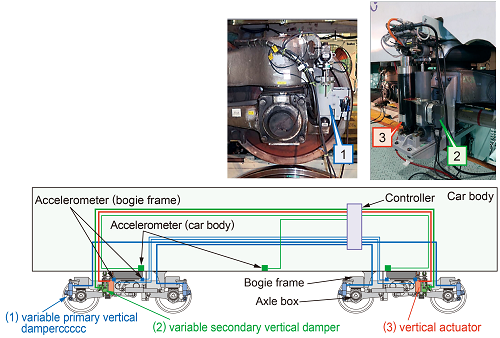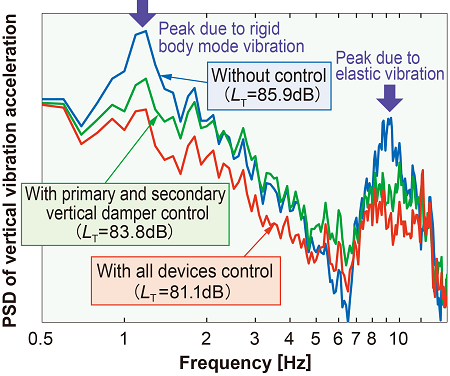21. Vertical vibration control method for Shinkansen rolling stock
The ride comfort onboard Shinkansen trains has been significantly improved following the installation on almost all trainsets of lateral vibration control devices.
As a result, vertical vibrations can be felt more, and so suitable measures are required in response to this. Vertical vibrations are made up of “rigid vibrations” produced by the car body moving as a whole, and “elastic vibrations” produced by car body deformation: both significantly impact ride comfort. Consequently, a new vibration control method was developed in response to both rigid vibrations and vertical elastic vibrations (Fig. 1).
The respective vehicle vibrations are controlled by mounting a variable primary vertical damper between the axle box and the bogie frame, and mounting a variable secondary vertical damper between the bogie and the car body. The variable primary vertical damper controls the elastic vibrations of the car body, while the other damper mainly reduces rigid body vibrations.
In addition, a newly developed highly responsive vertical actuator is added in between the bogie and the car body to further control and reduce both rigid body and elastic vibrations. This method exploits the positive mutual interaction of these control devices, optimizing vibration reduction / ride comfort improvement.
Nevertheless, the three types of control device can be used effectively in any combination or alone, and so can be used flexibly in any configuration depending on the desired ride comfort improvement to be achieved, or cost.
In order to verify the developed method, the devices were mounted on a Shinkansen equivalent vehicle, and excitation tests simulating actual running on the rolling stock test rig were carried out.
The results confirmed that the maximum ride comfort improvement that could be achieved was over 4 dB (LT value) (Fig. 2).
Other Contents
- 21. Vertical vibration control method for Shinkansen rolling stock
- 22. Aerodynamic brake design for higher Shinkansen running speeds
- 23. Method for increasing braking force of linear rail brakes
- 24. Development of a CPS contact wire for Shinkansen
- 25. Yield management method optimizing discount ticket sales quota
- 21. Vertical vibration control method for Shinkansen rolling stock
- 22. Aerodynamic brake design for higher Shinkansen running speeds
- 23. Method for increasing braking force of linear rail brakes
- 24. Development of a CPS contact wire for Shinkansen
- 25. Yield management method optimizing discount ticket sales quota


